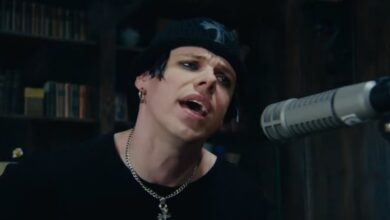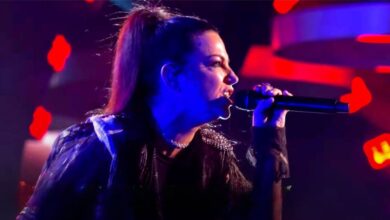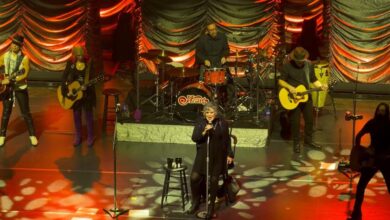Evanescence Ignite Saint Paul with Unforgettable “Going Under” Performance at 93X Family Reunion
The first thing you noticed was the date—September 19, 2025—and the familiar arena address in downtown Saint Paul. A local rock station’s banner turned the concourse into a festival welcome mat: 93X Family Reunion, starring Evanescence with Poppy and Dorothy. Doors opened early, merch lines formed fast, and the Xcel Energy Center hum turned into that pre-show electricity you feel in your ribs. This wasn’t just another tour stop; it felt like a regional homecoming, the kind of city-night where the poster becomes a keepsake and the setlist becomes a story starter you’ll tell for years.
Inside, you could read the room by the T-shirts—Fallen loyalists shoulder-to-shoulder with fans who arrived through The Bitter Truth. Conversations floated between meet-up plans and whispered hopes about deep cuts, while ushers compared notes on which sections usually start the first chorus-wide singalong. On the event page and ticket sites, the details had been clear for weeks—Evanescence headlining, Poppy bringing the industrial shimmer, Dorothy igniting the bluesy spark—and in the building those puzzle pieces clicked into a single picture: Saint Paul had set aside a Friday night for catharsis.
The lights fell, the stage bled midnight blue, and Evanescence stepped into focus with precision that felt cinematic. From the opening swell, Amy Lee’s voice arrived like a spotlight—clear, present, centered—cutting through the arena air with those vowels built for reverb. Early in the set, the band threaded in “What You Want” and “Afterlife,” both delivered with muscular tempo and clean separation in the mix, a tell that the FOH team had dialed the room for punch rather than brute loudness. Crowd chatter stopped being chatter; it became breath, timing, and anticipation.
Then came the moment everyone would talk about on the concourse: “Going Under.” Those opening guitar stabs and the descending vocal line still have a hair-trigger effect on a crowd—one second of hush and then an eruption. Phone screens lifted like a constellation as the downbeat hit, and within eight bars the floor moved as a single organism. Live clips would later surface in crisp 4K, but in the room the definition you felt was kinetic rather than visual: kick drum in the sternum, chorus melody in the throat, verse tension like a drawn bow.
What made “Going Under” feel special in Saint Paul was the balance between fidelity and evolution. The band didn’t chase a carbon-copy of the studio cut; they chased impact. Guitars carried a slightly more modern edge—less scooped, more articulate—while the rhythm section kept the pocket tight enough to let Lee stretch phrasing without loosening the song’s grip. In fan-shot angles you can hear the audience become a second chorus mic, a layered crowd harmony that’s half nostalgia and half adrenaline, the arena turning into a choir without ever losing the song’s bite.
Pacing is an underrated art, and the set around “Going Under” showed deliberate architecture. “Yeah Right” and “Call Me When You’re Sober” acted like tempo rails, keeping the energy high while changing color palettes; “The Change” and “Wasted on You” added that alt-goth glare the band has sharpened in recent years. It’s the kind of sequencing that lets a legacy hit bloom rather than loom—by the time “Going Under” arrived, the room felt primed to celebrate it instead of simply expecting it. That difference matters when you’re aiming for goosebumps over checked boxes.
Credit the players as much as the songs. The guitars articulated riffs with a melodic contour that sang even between vocal lines; drum accents snapped like punctuation, giving verses a percussive urgency that made the choruses feel like release valves. Keys and textures—the Evanescence secret weapon—filled negative space without fogging the mix, the harmonic padding under the pre-chorus acting like a runway for Lee’s leap to the hook. Saint Paul’s arena acoustics can be unforgiving; this mix felt designed to win the room rather than fight it.
Amy Lee’s presence carried that paradox she’s perfected: grounded and unshakeable, yet dialed into the song’s emotional voltage as if it’s happening to her in real time. On “Going Under,” her articulation clipped just enough on consonants to add urgency, then opened wide on vowels to let the melody bloom over the crowd. The camera angles that surfaced later caught the physicality—hands carving phrases, posture signaling dynamic shifts—but being there added a sense of risk, the tightrope thrill that only live air can provide.
Saint Paul’s crowd deserved its own credit line. This wasn’t passive nostalgia; it was active participation. Whole sections took turns leading call-and-response pockets, while the floor synchronized on the chorus like they’d rehearsed it in the parking lot. Security kept aisles clear without tamping enthusiasm, and by the bridge you could feel the back rows collapse forward in attention. When the last chorus hit, the arena didn’t just sing with the band—it surged, as if trying to meet the stage halfway with sheer decibel willpower.
One reason nights like this land: context. This show landed just forty-eight hours before the band’s headline-grabbing collaboration with Paul McCoy at Louder Than Life, but Saint Paul wasn’t a prelude; it was a fully realized statement of identity. The setlist here told its own story, moving from modern material to keystone tracks and back again, proving the catalog’s connective tissue holds under bright lights and big rooms. If Louisville would deliver the cameo headline, Minnesota delivered the sustained narrative arc.
You could see the ripple effect in real time. Song-by-song clips started landing online before the house lights even came up—angles from the pit, upper-bowl panoramas, zoomed-in shots dead center. A dedicated playlist of 4K captures appeared soon after, turning Saint Paul into a communal replay room for fans who wanted to relive that roar or verify the arrangement tweaks they swore they heard. In 2025, that’s part of the show: the second life that starts the minute the amps cool.
The supporting bill shaped the night’s contour, too. Dorothy’s gritty, blues-lit attack warmed the room with punchy choruses and big-hearted swagger, while Poppy’s razor-sleek industrial pop re-tuned ears for the headliner’s blend of heaviness and atmosphere. The combination worked like a three-act structure—ignite, disorient, cathartically resolve—so when Evanescence hit stage time, the audience had already taken the necessary journey to be ready for the main event’s emotional bandwidth. That careful curation is a quiet kind of showmanship.
From a logistics perspective, the Saint Paul stop looked dialed-in. Advance listings were consistent across official channels and ticketing partners, doors and show times landed close to posted schedules, and the arena’s traffic flow kept concessions busy without gridlock—no small feat on a stacked radio-station bill. Those operational wins aren’t glamorous, but they frame the music in comfort, and you could feel it in the crowd’s patience: fewer distractions, more oxygen for the songs to do their work.
As the set moved into late-show territory, dynamics stretched. Ballads like “My Immortal” turned the arena into a sea of phone lights, while anthems re-asserted the band’s claim on the night with widescreen choruses. “Bring Me to Life” would later make national headlines in another city for a special guest, but in Saint Paul it functioned exactly as it should: as a capstone of shared history, delivered with enough bite to feel current. The applause between songs got longer; the show felt shorter than the clock said.
When the last notes decayed and the screens dimmed, that familiar post-show murmur returned, louder and brighter: favorite song debates, breathless rankings, quick comparisons to earlier tours. Outside, the September air cooled faces still warm from the final chorus, and the sidewalks filled with people scrolling for clips they might already be in. What made the night special wasn’t one viral moment; it was accumulation—the proof that in 2025, Evanescence can still command a big American room and make it feel intimate, urgent, and unmistakably theirs.
And for those who measure shows by what lingers, Saint Paul left a resonance that lasted beyond the parking ramp. The setlist reads cleanly on the page, but the experience lived in the air between notes—the widened vowels, the drum-fill feints, the crowd’s unison surge on the hook of “Going Under.” It’s the sort of city-date you circle in memory later when someone asks, “Which show would you go back to if you could?” The answer here is easy: the one where the songs felt both exactly as you remembered and brand-new.





